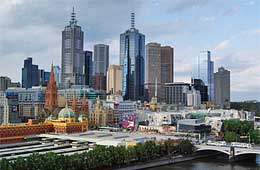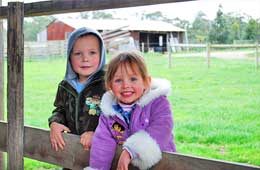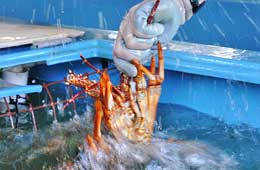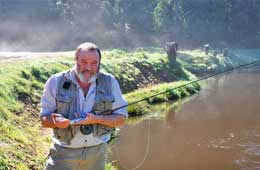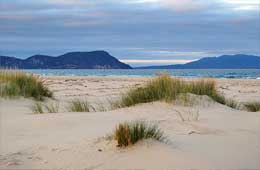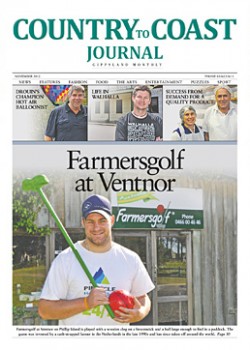Town and Country Farmer magazine
Truffle, also known as the ultimate mushroom, is the fruit of a fungus that grows under the ground as a result of a cooperative relationship with the roots of particular trees – generally oaks and hazelnuts that have been inoculated with the spore. Although truffle growing is an old European industry, it is a relatively new industry in Australia with enormous export potential and some success.
Graham Duell is vice president of the Australian Truffle Growers Association after a long held position as president. The association is the peak body for the truffle industry in Australia and receives federal support through the Rural Industries Research and Development Corporation to help develop the industry.
Colin Carter who until recently was a lecturer in horticulture, and manager of Horticulture and Environment at Swinburne University of Technology, has spent the last seven years researching and growing inoculated trees to produce truffle. He and his family also run Trufficulture, a Victorian truffle inoculation nursery and a truffière (truffle plantation) on their 20-hectare property in Gembrook. In 2009, Colin was awarded an ISSI (International Specialised Skills Institute) Tafe Fellowship sponsored by the Victorian Government to travel to Spain, Italy and France to study several aspects relating to improving cultural methods, propagation and looking at the potential for developing a quality system for inoculation nurseries.
Graham said truffles produced naturally have been harvested and valued since roman times through Southern France, Northern Italy, Northern Spain and parts of Croatia where during the eighteenth and nineteenth centuries, hundreds of tons were harvested. However, due to degradation of the area and loss of forest much less is harvested today. About 40 years ago, the French developed the process of artificially inoculating trees, which established the plantation industry and truffle is now produced throughout the same area in Europe in managed truffieres as well as in the wild.
He said a good yield in Europe is about 30 to 40 kilograms per hectare from a managed site, but the best-managed sites in Australia have exceeded that. Australia also produces truffles in winter, which is summer in the northern hemisphere when there isn’t fresh truffle about.
“Last year, Australia produced about four and a half tonnes of truffle valued at around five million dollars, and it’s believed in four years, it will be in excess of 10 million dollars. Most of what is produced is exported to Asia, North America and a small amount goes to Europe.”
Colin said he was first introduced to truffles while teaching his students about mycorrhizae (root fungus) on gum trees, when a teacher he employed mentioned he was putting in a truffiere. “The truffle mycorrhiza is native to European trees so I became interested.”
He said the reason our native trees survive and flourish in sometimes very poor and acidic soil with low phosphate is because they all have an association with a native mycorrhiza although not all have fruiting bodies. While there are some native truffles, they don’t have any culinary value.
In 2009, when Colin was sponsored to travel through Italy, France and Spain, he visited universities, truffle organisations and tree nurseries and learnt much more about producing truffles.
“European trees that produce truffle need to grow in nutrient depleted soils that are low in phosphate with a pH of 8. In Australia, we have to add a lot of lime to our acid soils to get the same pH level. That then locks up nutrients making them unavailable to the trees, but when trees are planted that are infected with the mycorrhiza it solubilises those nutrients, feeds it into the trees roots, and in turn takes simple sugars and moisture from the tree for its own survival. The tree would not survive very well in a soil of pH8 without a good symbiotic relationship with the truffle mycorrhiza.”
For the last five years, Colin and his wife Jan, their daughter Kaitlyn and son Nathan, have been supplying truffieres with inoculated species of common English oak, holly oak and hazelnut which are native to Europe.
They inoculate the trees with four different truffle varieties, the most widely used winter French black Périgord truffle, a summer black truffle and two white truffles – the bianchetto which is coffee coloured and grows on oaks and pine nut trees, and the magnatum which he said is the holy grail. “The magnatum is an Italian white truffle that gets three times the price of the French black but only grows in natural forests. We can colonise it on trees but no one in the world has grown a magnatum truffle in an artificial truffiere. It grows on the sides of creeks and may have slightly different soil and moisture requirements.”
Colin and Jan have also put in a one-hectare experimental truffiere. He said when they started, the pH was about 5.8 and they had to add 70 tonne of lime to get a pH of 8. They’ve planted 12 inoculated species of oaks, the oldest now in its fourth year, to produce a few varieties of truffle.
“We are also doing experimental work on the Linden tree, which in Croatia produces beautiful black truffle. It also has very highly scented yellow flowers and is renowned for the honey it produces. No one has made these trees available yet but they grow like oak and are ideal for anyone wanting to value add by keeping bees in their truffieres.”
He said it’s difficult to value add using the trees because of the different fertiliser, harvesting and water needs. Hazelnut trees for example need a pH of 6.5 and irrigation to produce a commercial crop of hazelnuts. The trees mycorrhiza would survive but wouldn’t produce truffle.
“Many truffle producers plant multiple hectares of plantations. They plant one and if they are suffering low yields, they put in another hectare. What we want to do is replace trees that aren’t producing and get to a stage where the one hectare produces a lot of truffle. Not everyone has that experience but it is possible to get 60 kilograms from one hectare.
“The truffles usually start to appear after about four years but it’s different for different people. Some may never get a truffle but science has come a long way in the last few years. Not using fertilisers increases the bio activity under the tree because there are beneficial bacteria involved in the process.We know truffles will do well in well-drained, aerated soils and the best aspect is facing north or north east to the west. The worst place to plant is on a steep site sloping south because in winter there isn’t enough light under the trees to ripen the truffles, and river flats that are wetter for longer during winter.
“The trees grow with minimal pests and diseases so you can be an organic farmer. You may get a few aphids on the oaks but the birds usually eat them. If we have to spray at all, we use garlic or chilli sprays and we mow or slash the grass.”
He said the truffle industry started like all industries without a certification program for the trees, which allowed anyone to do anything, and then claim to have colonised trees, so in February 2012, The Australian Truffle Growers Association paid for him to go to Spain to study the Spanish certification. “I went with a researcher from the Australian National University in Canberra, who will be doing the independent testing, and my son Nathan who paid for himself. We have now written up the paper for Australia using the Spanish system. It is currently being reviewed and should be in place for the coming season.
“There is a huge cost involved that’s yet to be determined, but it will mean a few dollars added to the price of every tree. We believe most people will be prepared to pay a few more dollars to make sure the trees are independently certified because they won’t want to pay $25 per tree and find out in 10 years’ time that they weren’t properly colonised. It’s a huge change but I think it will give the industry more surety and maybe in the future we will see higher levels of truffle production coming from new plantings because the trees will be better.”
By Wendy Morriss
Copyright © 2013 Wendy Morriss: Freelance Journalist. All Rights Reserved
